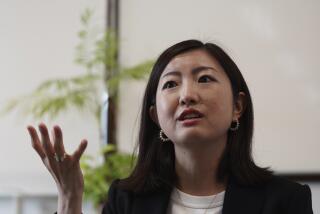Nippon Crew Enjoys Challenge : Sailing: Novices get behind a veteran leader to produce outstanding results.
- Share via
SAN DIEGO — They could write the test in 1992, but go back several years and these Pacific Rim crewmen would have failed even a one-question quiz miserably.
Five years ago, for all Nippon team members Ken Hara and Yoshiya Sasaki knew, the America’s Cup was a tennis or golf extravaganza staged annually.
Hara, a college soccer player, and Sasaki, a former volleyball standout, hadn’t the first inkling of what a yacht race was all about.
How unlikely then, that on the dawn of the third day of the challenger semifinals, the Nippon team finds itself one of the two favored syndicates to sail off with the Louis Vuitton Cup, which would put them in May’s grand sailoff against the winning defender.
But there Hara and Sasaki were in 1987, answering a personnel ad from a national sports magazine seeking:
Males, age 20-30. Must be 6-feet tall and weight 75 kilograms. Need five-year commitment, no experience necessary.
“I had nothing planned after I graduated university,” said Hara, whose yacht-club friend persuaded him to apply. “I weighed just enough.”
Hara’s sense of adventure proved a greater commodity than his interest in sailing--which he said did not exist. He went for a physical fitness test along with 300 candidates, and within a month, 12--seven had no experience--were chosen for what has become Asia’s premiere sailing squad.
Family is held in high regard in Japan. Hara’s parents said to do as he pleased, but Sasaki was unsure his family would approve of him giving up a promising computer job to pursue a dream of which they had no understanding.
“After I explained to my parents what I was doing, they said, ‘Oh, you’re a fisherman,’ ” Sasaki said.
Hara and Sasaki have been with the syndicate from Day 1, when the eager but inexperienced athletes were trying to find their way out of the harbor.
“I had no sailing background,” said Sasaki, who had become bored with the business lifestyle. He yearned for any challenge sports could offer.
“It is difficult to say what I wanted to get out of this, but it was important to do. I had a strong confidence in myself that I could be successful,” he said. “Sailing gave me that opportunity. But this could have been swimming, golf, anything. I still would have taken it.”
For the first three months, the crew lived like gypsies as they searched for harbors and crews to test their slowly evolving skills. Some quit soon after, not knowing what was the future held.
“They were worried. They thought it was better to find another job,” said Hara, who since has trained upward of 9,000 hours.
Nippon’s on-the-job training included the Congressional Cup in Long Beach, its first major international competition. The crew belly flopped, going oh-for-9 and finishing last in the 10-boat field.
“Sailing looked very easy,” Hara said, “but match racing was very hard for us. It was very disappointing. We had no good techniques.”
Or teachers with world-class experience. So the Japanese hired American coaches Gary Jobson and Stu Argo.
Nippon had a sampling of success at its second Congressional Cup. In 1989, the syndicate won races against three Americans, including ESPN analyst Peter Isler.
“People were very surprised we did well,” Hara said.
Eventually, the Japanese looked to neighboring New Zealand for help. Chris Dickson came aboard in 1990, and was subsequently named skipper in favor of Japan’s chief driver, Makoto Namba, now Nippon’s captain.
Under Dickson’s tutelage, the Japanese have blossomed. He raised the work ethic, and immediately earned the respect of the challengers.
“When Chris came, he pushed us very hard,” said Hara, who has sailed with Dickson on the World Match Racing Circuit. “We started to figure what is the America’s Cup. He is the No. 1 ranked match racer in the world the last three years. People expect him to win.”
Sasaki said, “Chris is a good role model. He’s been a great driving force during our progress. Whenever we had frustrations, he’d tell us that hard work can lift you to the next level.”
That level seemed miles away at the International America’s Cup Class World Championships last year, when Nippon broke a mast and had a man overboard in separate incidents.
“Disappointing yes. Embarrassing no,” Sasaki said. “Those lessons were very meaningful. We were lucky to go through them then, and not in the America’s Cup.”
In a country where nationalism appears xenophobic to outsiders, much ado had been made of Dickson’s central role with the syndicate. But he is a big part of Japan’s success story--Nippon was in first place coming out of the third-round of the trials.
Without him, the crew readily admits, the odds of Japan winning in its first appearance would diminish greatly.
“Without experienced America’s Cup people, maybe it would not be impossible, but very difficult (to win),” Hara said. “Without foreign people, we could not have progressed like we have.”
Nippon crew members hope that sailing becomes more popular back home upon their return.
“It may take a while, but it would be great to have a job (in sailing) when I go back,” Hara said.
For now, his job is clearly defined: A berth in the challenger finals and the final.
“In the beginning the purpose was to get to the semifinal. We did that,” Hara said. “Now it’s to win the Louis Vuitton Cup. I think we can do it. We feel happy, but not pressure. We are confident.”


